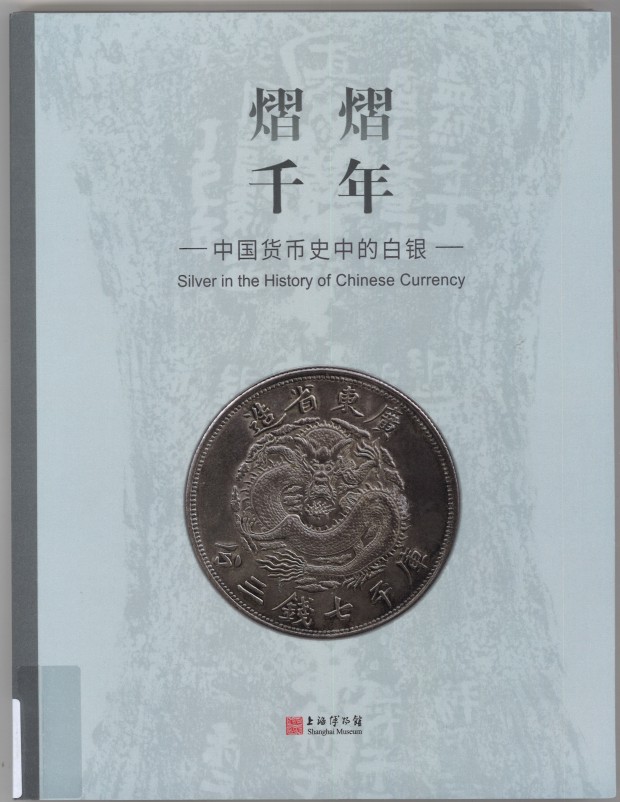Shanghai Museum (ed.), Yiyi qian nian: Zhongguo huobi shi zhong de baiyin. Shanghai: Shanghai Museum, 2019. ISBN ISBN 978-7-5479-1987-3. 187 pp.
上海博物馆 编:《熠熠千年:中国货币史中的白银》 / Silver in the History of Chinese Currency. 上海: 上海博物馆, 2019 年。
This is the catalogue of the exhibition at the Shanghai Museum, in 2019. Curated by Wu Danmin, the exhibition centred on the Shanghai Museum’s excellent collection, with loans from China’s Finance and Taxation Museum 中国财税博物馆, the Sichuan Provincial Cultural Relics and Archaeological Research Institute 四川省文物考古研究院副院长, the National Center of Underwater Cultural Heritage 国家文物局水下文化遗产保护中心, and Guangdong Provincial Institute of Cultural Relics and Archaeology 广东省文物考古研究所 . The index (in Chinese and English) gives the captions to the 130 objects illustrated in the catalogue.
There are four forewords (in Chinese and English):
YANG Zhigang 杨志刚, Director, Shanghai Museum (pp. 6-7)
XU Xiang 徐向, China’s Finance and Taxation Museum (pp. 8-9)
TANG Fei 唐飞, Vice Dean, Sichuan Archaeology Research Institute (pp. 10-11)
SUN Jian 孙键, National Center of Underwater Cultural Heritage (pp. 12-13)
These are followed by four essays (in Chinese, with an English abstract):
WU Danmin 吴旦敏 — Zhongguo huobi shi zhong de baiyin 中国货币史中的白银 // The Silver in the History of Chinese Currency (pp. 14-20)
Abstract: The natural attributes of gold and silver give them the advantage over other metals to function as a form of payment. In Europe the history of silver working as currency and as vessels or adornments had virtually overlapped while it was not the same in China. Silver had been valued as precious metal as well as long-distance exchange media in the history of Chinese currency until by the end of sixteenth century that it became a standard currency in the monetary system. The Age of Exploration in the fifteenth century speeded up the global circulation of silver and saw its enormous influx into China which fueled the metallic currency market. To some extent, the maritime trade stimulated China’s commerce and industry, and urged a more advanced currency system to match its development. Silver eventually acted as a significant role on the stage and backed all of China’s economy.
CHEN Yang 陈阳 — Baiyin huobi beihou de caizheng tuishou – Tangdai zhi Mingdai yinding zhong suojian baiyin yu caizheng de guanxi 白银货币背后的财政推手 – 唐代至明代银锭中所见白银与财政的关系 // Pushing Hands Behind: The Relationship between the Silver Ingots and the Finance from the Tang to the Ming Dynasties (pp. 20-27)
Abstract: The thesis attempts to reveal the relationship between silver ingots and government’s income and expenditure on the analysis of the inscriptions and text material based on various forms of silver currency from the Tang to the Ming dynasties. It aims to investigate how the national’s finance and taxation system worked out to set up a silver standard monetary system through the functions of silver currency transferred from a method of large-scale payment in common commodity to considerable tax generated from goods in great volume of trade.
LIU Zhiyan 刘志岩 — Zheji chensha yin wei xiao: Jiangkou chen yin yizhi fajue ji 折戟沉沙银未销:江口沉银遗址发掘记 // The Underwater Archaeological Finding of Silver from the Jiangkou Site (pp. 28-32)
Abstract: This paper is aimed to tell the inside stories of the underwater archaeological finding of a sunken silver hoard in Jiangkou from the perspective of the archaeologist on-site, with some unrevealed details of how the site was discovered and excavated as well as the spiritual journey that the author experienced in the whole process. The article focuses on recording the archaeologists’ efforts in this first underwater practice in Sichuan province and so far the largest scaled underwater archaeological excavation of rivers in China. This tremendous discovery proved the legend of Zhang Xianzhong hiding a large silver treasure underwater at Jiangkou a real story and once again, the significance of archaeological evidence in the study of Chinese history.
YE Daoyang 叶道阳 — ‘Nanhai yihao’ chutu de yi pi jinshu huobi ‘南海一号’出土的一批金属货币 // Metal Coins Excavated from the Nanhai I Shipwreck (pp. 33-35).
Abstract: The Nanhai I shipwreck was originally located in the border area between Taishan City and Yangjiang City of Guangdong Province. It was discovered in the late 1980s. Afterward, the wreck was entirely unwatered and shifted to the Maritime Silk Road Museum of Guangdong in 2007. It has been conducted with excavation since 2014. It is a very important discovery so far in the history of China’s underwater archaeology. It is also very important relics along the Maritime Silk Road. // The Nanhai I shipwreck was basically preserved under sea mud. It is loaded with cargo of trade goods of the Southern Song Dynasty. The wreck is 22 meters long and 9.9 meters wide, with a sharp bow, square stern and multiple plates on both sides. Its structure is suitable for seagoing voyage, known as ‘Fu Chuan’, or literally Fortune Ship. // The Song dynasty was a prosperous period for China’s coinage industry. Silver began to circulate as an important part of the financial system. The development of overseas trade led to an increasing importance of the precious metals such as gold and silver of high value, light weight and convenient for long distance transportation. The Song people normally call it ‘light assets’ for both the silk and precious metals. // In the wreck, 290 kg of silver ingots have been excavated. It has also yielded a lot of gold leaves, as well as a large quantity of gold, silver and copper coins. The silver ingots displayed in this exhibition were intended to be carried abroad for use, so that the audience can also imagine the scenery of prosperous foreign trade in the Song Dynasty.
These are followed by the catalogue in three sections:
Chuantong yinliang 传统银两 // The Traditional Silver Ingots (pp. 36-95)
Baiyin dongzhe 白银东浙 // Silver Travelling to the East (pp. 96-127)
Yin yu zhichao 银与纸钞 // Silver and Paper Money (pp. 128-181)
Suoyin 索引 // Index (pp. 182-186)

